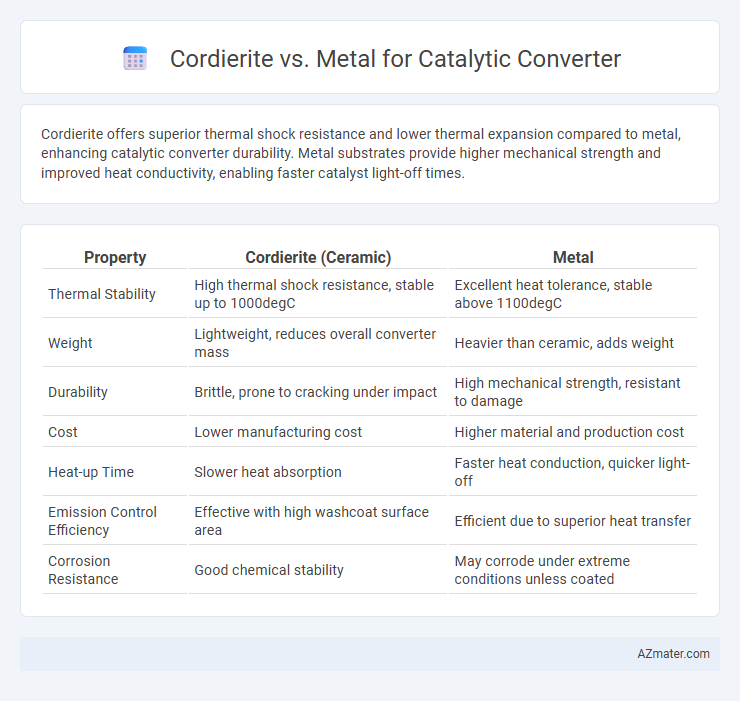Cordierite offers superior thermal shock resistance and lower thermal expansion compared to metal, enhancing catalytic converter durability. Metal substrates provide higher mechanical strength and improved heat conductivity, enabling faster catalyst light-off times.
Table of Comparison
| Property | Cordierite (Ceramic) | Metal |
|---|---|---|
| Thermal Stability | High thermal shock resistance, stable up to 1000degC | Excellent heat tolerance, stable above 1100degC |
| Weight | Lightweight, reduces overall converter mass | Heavier than ceramic, adds weight |
| Durability | Brittle, prone to cracking under impact | High mechanical strength, resistant to damage |
| Cost | Lower manufacturing cost | Higher material and production cost |
| Heat-up Time | Slower heat absorption | Faster heat conduction, quicker light-off |
| Emission Control Efficiency | Effective with high washcoat surface area | Efficient due to superior heat transfer |
| Corrosion Resistance | Good chemical stability | May corrode under extreme conditions unless coated |
Introduction to Catalytic Converter Materials
Cordierite and metal are the primary materials used in catalytic converter substrates, each offering distinct thermal and mechanical properties crucial for emission control. Cordierite, a ceramic material, provides excellent thermal stability and low cost, making it ideal for standard passenger vehicles, while metal substrates offer superior durability and heat resistance suitable for high-performance and heavy-duty applications. The choice between cordierite and metal directly impacts the converter's efficiency, heat tolerance, and overall lifespan in reducing harmful emissions.
Overview of Cordierite in Catalytic Converters
Cordierite is a ceramic material widely used as a substrate in catalytic converters due to its excellent thermal stability and low thermal expansion, which enhances durability under high-temperature exhaust conditions. Its porous structure allows for efficient coating with catalytic metals like platinum, palladium, and rhodium, optimizing the conversion of harmful gases such as CO, NOx, and hydrocarbons. Compared to metal substrates, cordierite offers superior insulation properties and resistance to thermal shock, making it a preferred choice in conventional automotive catalytic converters.
Properties of Metal Substrates
Metal substrates for catalytic converters offer superior thermal conductivity and mechanical strength compared to cordierite, enabling faster light-off times and enhanced durability under extreme temperature fluctuations. The high resistance to thermal shock and the ability to endure frequent heating and cooling cycles make metal substrates ideal for modern engines with advanced emission controls. Furthermore, metals such as stainless steel provide a flexible structure that supports thinner walls and higher cell densities, improving catalytic efficiency and reducing backpressure.
Thermal Stability: Cordierite vs Metal
Cordierite offers excellent thermal stability with a high melting point around 1470degC, making it resistant to thermal shock and suitable for standard catalytic converter applications. Metal substrates, typically made from stainless steel or other alloys, can endure rapid temperature fluctuations and higher thermal cycles without cracking, enhancing durability in high-performance or diesel engines. Metal substrates also provide superior heat transfer properties, ensuring quicker light-off temperatures for efficient emissions control.
Durability and Lifespan Comparison
Cordierite catalytic converters exhibit high thermal durability with resistance to thermal shock, making them ideal for standard vehicle emissions but prone to cracking under extreme temperature fluctuations. Metal catalytic converters, often made from stainless steel or metallic alloys, provide superior mechanical durability and a longer lifespan due to enhanced resistance to corrosion and physical damage. The lifespan of metal catalytic converters typically exceeds that of cordierite units, especially in harsh operating conditions or vehicles exposed to frequent temperature cycling.
Efficiency in Emission Control
Cordierite ceramic substrates in catalytic converters offer superior thermal durability and excellent oxidation resistance, enhancing emission control efficiency by maintaining catalyst activity at varying temperatures. Metal substrates, typically made from stainless steel, provide faster light-off times due to better heat transfer, leading to quicker activation of the catalyst and reduced cold-start emissions. Both materials impact the converter's overall emission control performance, with cordierite excelling in stable, long-term operation and metal substrates optimizing early-stage emission reduction.
Cost Analysis: Cordierite vs Metal
Cordierite catalytic converters typically offer a lower initial cost compared to metal substrates due to their widespread availability and simpler manufacturing process. However, metal catalytic converters, although more expensive upfront, provide enhanced durability and higher thermal resistance, potentially reducing long-term replacement and maintenance costs. Cost analysis must also consider vehicle type, emission standards, and operational lifespan to determine the most economical substrate choice.
Weight and Design Flexibility
Cordierite catalytic converters are significantly lighter than metal counterparts, reducing overall vehicle weight and improving fuel efficiency. The ceramic structure of cordierite offers enhanced design flexibility, allowing for complex shapes and optimized surface area to increase catalytic reaction efficiency. Metal converters, while more durable at high temperatures, tend to be heavier and less adaptable in intricate designs compared to cordierite substrates.
Suitability for Automotive Applications
Cordierite offers excellent thermal stability and low thermal expansion, making it highly suitable for catalytic converter substrates in automotive applications where rapid temperature fluctuations occur. Metal substrates, typically made from stainless steel or other alloys, provide superior mechanical strength and faster light-off times due to their higher thermal conductivity. Choice between cordierite and metal depends on factors like engine type, emission standards, and durability requirements, with cordierite favored for cost-effective applications and metals preferred in high-performance or heavy-duty vehicles.
Choosing the Right Material for Catalytic Converters
Cordierite offers excellent thermal shock resistance and lightweight properties, making it ideal for catalytic converter substrates in passenger vehicles. Metal substrates, typically made from stainless steel, provide superior durability, faster light-off times, and better resistance to thermal degradation, which benefits heavy-duty and high-performance applications. Selecting between cordierite and metal depends on factors like operating temperature, vehicle type, and emission standards, ensuring optimal converter efficiency and longevity.

Infographic: Cordierite vs Metal for Catalytic converter
 azmater.com
azmater.com